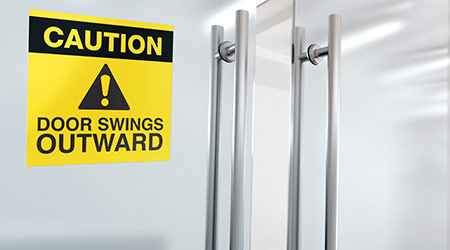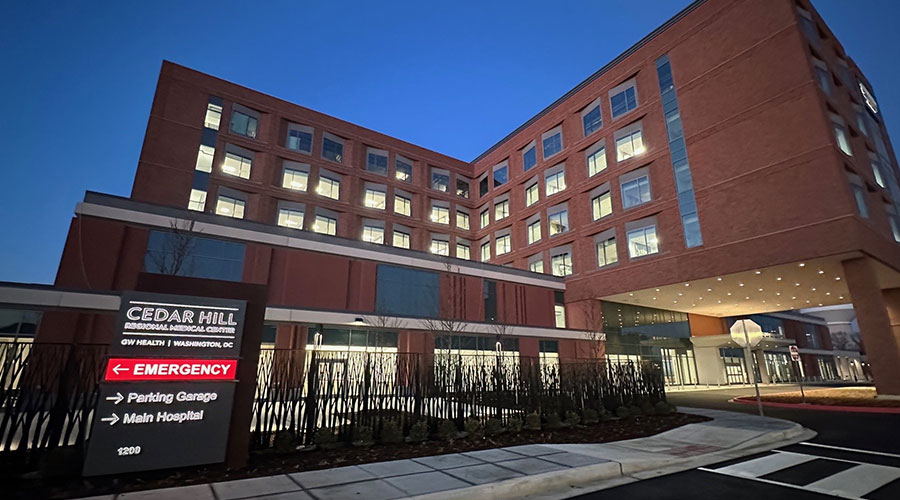Throughout hospitals and research labs, signs are used virtually everywhere from the front door and patient rooms, to the OR and ER, to research and test areas, to the routes and maps for emergency exits. Signs are used in many ways, whether informal, formal, or mandated by law, and vital interim life safety signage can often be required.
Permanent signs may not be an option when the information changes and needs to be updated. This can occur when policies and procedures change or during community events, such as volunteer orientation and open houses.
“In hospitals, temporary signs are used for directional navigation, identifying rooms and escape routes, as well as to provide warnings and precautions about various hazards,” said M. Geary, an EHS manager at a university hospital. “This is particularly important when any construction, remodeling, or refurbishing is occurring.”
Safety notifications, including emergency contacts and potential hazards may also change frequently in research labs, particularly at universities where these may change as often as every semester when new projects may commence.
In such temporary situations, the traditional signage options for administrators and facility managers are limited. Because signs can be located in high traffic areas and subjected to harsh cleansers, the sheets of paper, cardstock, sheet protectors, laminated sheets, and posters used must not only present a professional image, but also stand up to the environment and even meet specific safety codes.
This is where the problem lies. Since many signs are not designed for high traffic use, they may not look professional or be resistant to wear and tear from frequent touching, handling, or the cleansers used in such environments. As a result, they are damaged easily and must be replaced frequently.
Many signs can also cause considerable damage to the underlying surfaces when taped, tacked, nailed or screwed to walls, glass, or equipment, which can hasten the need for costly repair and repainting. Sign removal can also leave behind unsightly residual tape or adhesive. This is exacerbated when signs include information that is routinely changed or updated.
With premature facility repair and wall repainting costing hospitals and large research labs thousands of dollars in annual maintenance, the ideal solution would be signage that is easy to install, durable enough to endure harsh conditions, yet comes off easily when necessary, leaving no trace. This can significantly reduce the need for facility maintenance, freeing up resources for higher priority purposes.
“Commercial-grade labels used as signage must be more durable than those used in a lower use area, but also should remove cleanly when they need to come down,” says Tina Huff, Group Product Manager at Avery Products Corporation. “For us, the key to accomplishing this was developing an adhesive that holds well but can be removed when needed. Achieving that balance is harder than it sounds.”
As a result, Avery created Surface Safe Sign Labels – an exclusive, proprietary product specially engineered to stick securely yet remove cleanly without damage or residue from painted walls, doors, windows, furnishings, equipment, and other interior surfaces.
These “labels used as signs” are made of durable, commercial-grade material that resists water, chemicals and even abrasion. Available in a variety of sizes, they print easily on standard laser or inkjet printers, opening a world of possibilities for custom, do-it-yourself signs.
Unlike standard office labels with a paper substrate, the topcoat of the commercial-grade sign labels is waterproof and chemical resistant, while its polyester substrate is a durable, scuff and tear-resistant film.
These qualities are ideal for safety-related signage mandated by regulation or required by administrative policy.
“We do a lot of interim evacuation routes in our hospital and have to post temporary signs along these routes,” said Geary. “Whenever you change exit routes, due to construction or other reasons, you have to train staff and post appropriate signage identifying the new routes. The removable Surface Safe sign labels are perfect for this. They are also useful in the clinics as door postings to notify personnel to take necessary precautions, such as when a patient is TB positive.”
Such removable signage is also helpful in meeting required standards at a reasonable cost for temporary projects.
“We are able to create customized ANSI standard signage using the labels – for example, a Notice sign above pull stations while a building fire system is being repaired,” said Geary. “A custom sign like that could cost about $40 each. For one time temporary projects, it would be much better to simply print it on demand at a lower cost.”
The removable signage is also helpful in lab settings, particularly those that change frequently.
According to Geary, the OSHA Laboratory Safety Standard requires safety notifications, including emergency contacts and potential hazards at the entry to a lab as part of the Hazard Communication to ensure anyone entering is informed of the risks and wears necessary personal protective equipment (PPE).
“The removable signs are great for posting in areas with high lab turnover, or short term projects, particularly university or R&D labs,” said Geary. “Because the people and the chemical hazards change frequently in such settings, using a permanent sign is not practical.”
Administrators, facility managers, and safety officers will also want signs compliant with OSHA 1910.145 (Specifications for Accident Prevention Signs and Tags) and ANSI Z535.4 (Product Safety Signs and Labels).
Although standardized safety signs can be purchased out of catalogues, there is often a need to modify or customize mandated signage as conditions or formats change.
On-demand printing solutions, however, have traditionally required a large upfront investment of thousands of dollars, including a specialized sign and label printer, software, labels, and ribbons.
In response, industry innovators such as Avery have developed a simplified, flexible approach using standard laser and ink jet printers. The company’s free online Design and Print Software enables customizable printing utilizing OSHA/ANSI compliant templates.
Hospital and research lab staff can create and print their own informal, formal, or compliant labels from pre-designed templates or create them step-by-step on demand at a desk or service counter. Most find the process intuitive, since it resembles creating an office document from pre-designed templates.
“Now we print the removable labels on demand in whatever format we need,” said Geary. “They stick securely on every surface in our facility including paint, drywall, windows, wood, plastic, and metal. Because they peel off cleanly without leaving any residue, we can even reuse them as well.”
With the variety of signage used throughout hospitals and research labs, the ability to conveniently print new sign labels in minutes and cleanly remove the old will go a long way toward keeping the whole medical research community safely up to date and professional looking without the hassle, mess or cost.

 Design Plays a Role in the Future of Healthcare
Design Plays a Role in the Future of Healthcare Cedar Hill Regional Medical Center GW Health Officially Opens
Cedar Hill Regional Medical Center GW Health Officially Opens Designing Healthcare Facilities for Pediatric and Geriatric Populations
Designing Healthcare Facilities for Pediatric and Geriatric Populations Kaiser Permanente Announces New Hospital Tower at Sunnyside Medical Center
Kaiser Permanente Announces New Hospital Tower at Sunnyside Medical Center Building Disaster Resilience Through Collaboration
Building Disaster Resilience Through Collaboration